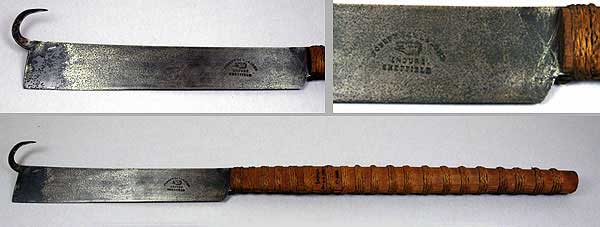File:1928.59.21.jpg
1928.59.21.jpg (600 × 227 pixels, file size: 19 KB, MIME type: image/jpeg)
Information This is a Samoan nifo’oti of the late 19th century. The haft is made from a single piece of wood, which has been split at the top to hold the tang of the blade, and has been bound at 20 points along its length with coconut fibre. The blade is that of a billhook, which bears the stamp of a small Sheffield cutler firm, Joseph Beal & Sons.
A Place in History This weapon, now considered by many to be synonymous with traditional Samoan weaponry, is a fine example of the complex historical ‘blurring’ of indigenous traditions and imported ideas that may occur in colonised areas in the period after European contact.
Although the Samoans used blades before the arrival of the Europeans in the 17th century, these were made of wood or stone. Nifo‘oti are generally termed ‘bush knives’ when spoken of by Samoans in English and are thought of as a type of club, but they are not indigenous to Samoa. The practice of hafting imported, European ‘trade’ blades became widespread and though many were intended as tools, it did not take much imagination to convert them into weapons of war. A nifo’oti blade is actually that of a European billhook and this example is stamped with the makers mark ‘JOSEPH BEAL & SONS, SHEFFIELD’ along with their trademark ‘ENDURE’ and a boar’s head. Beal’s were one of many English firms who made blades adapted for colonial markets around the world. Their blades have been found on a Native American sword, a Burmese knife and an Indonesian dagger.
‘Nifo’oti’ is a literal description of the hook, translating as ‘tooth at the end.’ Billhooks were traditionally used in agriculture and forestry, and continue to be used for laying hedges. When used for hedging, the blade is used to cut two-thirds of the way through the branches of the thorny tree species, and the hook is used to pull the branch downwards and lay it at an angle, pointing uphill. The hook is therefore essential for handling very thorny species such as hawthorn, blackthorn or blackberry. However, a billhook hafted onto a long wooden haft becomes a useful machete-like weapon.
Numerous fanciful interpretations have been postulated for what use the hook could serve as part of a nifo‘oti. Some thought it was for impaling the removed head of a defeated enemy in order to take it home in triumph, whilst others assumed it was for hooking under the enemy’s ribs, in order to pull him from the front of battle, so that he might be attacked more easily. Both ignore the fact that a nifo‘oti is much shorter, and therefore less appropriate for such tasks, than almost all Samoan clubs and spears. This is not to deny that they were weapons - and unquestionably very effective ones - but since they were traded as agricultural tools, they were probably used most often for this original purpose, only lending themselves to warfare in impromptu circumstances.
Since there both steel and wooden machetes and cutlasses elsewhere in western Polynesia during the 19th century, it has been suggested that there were not enough steel billhook blades to supply demand, so copies were carved out of wood. There is on display in the Museum a fine example of one such wooden nifo’oti.
File history
Click on a date/time to view the file as it appeared at that time.
| Date/Time | Thumbnail | Dimensions | User | Comment | |
|---|---|---|---|---|---|
| current | 04:56, 12 November 2008 | 600 × 227 (19 KB) | Linden (talk | contribs) | Information This is a Samoan nifo’oti of the late 19th century. The haft is made from a single piece of wood, which has been split at the top to hold the tang of the blade, and has been bound at 20 points along its length with coconut fibre. The blade i |
- You cannot overwrite this file.
File usage
The following page uses this file:
